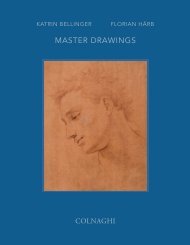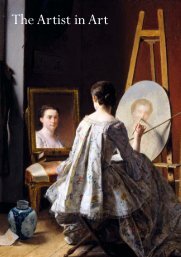2007 Catalogue - Colnaghi
2007 Catalogue - Colnaghi
2007 Catalogue - Colnaghi
Create successful ePaper yourself
Turn your PDF publications into a flip-book with our unique Google optimized e-Paper software.
sense of being unseen onlookers into the rituals of the<br />
female toilette and the pose of the lady, seen in full<br />
profile, rather than straight on, is much more<br />
meditative and romantic. Its sideways half-length<br />
composition and fluid handling link it closely with the<br />
subject of Evening, which survives both in painted<br />
form in a picture dated 1734 in a New York private<br />
collection 6 and in the form of two engravings: one, part<br />
of the series by Petit and the other, an English<br />
mezzotint. 7<br />
Our picture belongs to a group of almost life-sized<br />
genre paintings executed during the 1730s, a period in<br />
which Boucher was capitalizing on the French taste for<br />
seventeenth century Dutch genre paintings and the<br />
interest in La Vie Moderne which had been successfully<br />
exploited by de Troy. Stylistically, the dense clear<br />
handling and firm structure of the image in which a<br />
few large forms are clearly delineated and contrasted,<br />
points to a dating in the mid 1730s, contemporary<br />
with Evening. If, as seems probable, it is the painting<br />
recorded in Tessin’s inventory, it may well have been<br />
acquired around 1739, when he is first recorded as<br />
having visited Boucher’s studio. The group of intimate<br />
60<br />
half-length depictions of fashionable ladies seen in<br />
close up to which our picture belongs, heralds the more<br />
elaborate depictions of fashionable ladies in interiors<br />
such as Le Dejeuner of 1739 (The Louvre, Paris) and<br />
the Woman fastening her Garter with her Maid of 1742<br />
(Thyssen-Bornemisza Collection, Madrid) the last of<br />
which was commissioned by Tessin. Even more<br />
directly, the series to which this painting relates, looks<br />
forward to another projected series of paintings of the<br />
Times of Day, commissioned in 1745 by Tessin for<br />
Crown Princess Lovisa Ulrica of Sweden, for which<br />
only the The Milliner/The Morning (National museum,<br />
Stockholm), of 1746, was ever executed. There,<br />
however, the young lady who is also seated at her<br />
dressing table, is portrayed in a much more elaborate<br />
interior, turning towards the viewer to examine some<br />
ribbons brought to her by a young milliner.








